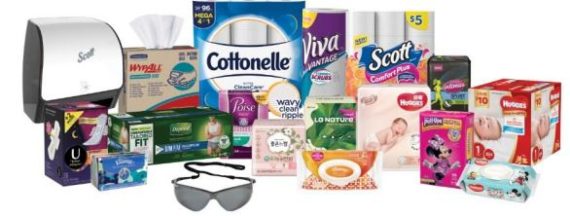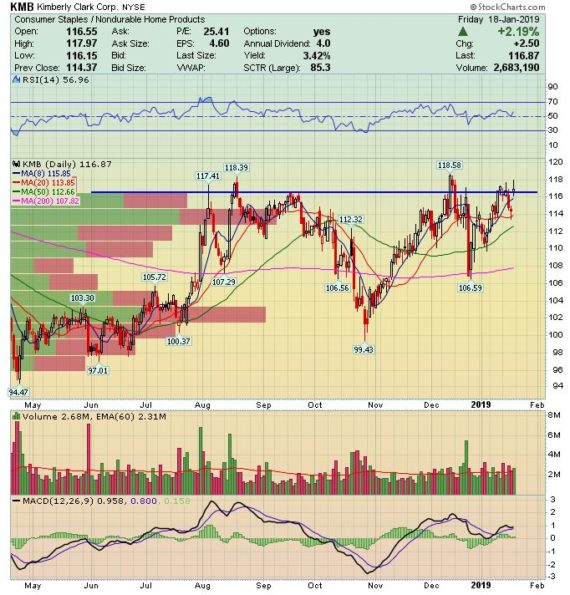Kimberly-Clark (KMB) – Checking In
On Wednesday, January 23rd, consumer staple Kimberly-Clark will report Q4 earnings. Ahead of the report, let’s take a look at what analysts are expecting:

BAML – By segment, they are forecasting its Consumer Tissue segment to be flat, Personal Care segment to increase 1%, and K-C Professional segment to increase 2.5%. “Per our mapping work, we see the potential for Consumer Tissue to report negative organic sales, though note that the comp is materially easier at -2% in the year-ago period vs +2% last quarter. In Personal Care, we are comfortable with our estimate, notably given an improvement in the diaper trends per tracked-channels (+1.8% L12W in the US vs – 1.2% last quarter).”
While in theory, risk/reward should skew more positive for 2019, especially with shares trading about in line with historical averages, BAML sees several risks worth keeping in mind:
1. Competition remains intense, and sustained need to invest in price promo is a margin headwind, especially in Consumer Tissue, where private label has gained share in recent years.
2. Decelerating FORCE savings and more raw materials pressure than what spot rates would imply as KMB laps a 2018 that was flattered by favorable pulp contracts which are not anticipated to repeat.
3. Risk of tepid guidance if new CEO Hsu looks to reset expectations on performance in order to enact changes for the longer term.
JPMorgan – On January 18th, analyst Andrea Teixera upgraded shares to Overweight from Neutral saying that following two consecutive years of operating margin challenges, they believe KMB’s margins can inflect positively in 2019 driven by:
1. Price Increases – As announced in August, Kimberly-Clark is increasing effective prices on its North American and European consumer products in the +MSDs to HSDs range in order to improve profitability following a year of significant pulp price inflation. The company also plans to increase prices in Latin America in the double digits. The majority of price increases are expected to begin flowing through in 1Q19 and should help drive top line growth and gross margin expansion.
2. Waning Input Cost Inflation Allows Pricing & Cost Savings Flow-Through – Based on current RISI pulp price forecasts and the slump in oil prices, we believe that significant input cost pressures seen over the last two years (~$370M in 2017 and JPMe ~$740M in 2018) could potentially shift from a headwind to a small tailwind in 2H19.
RBC Capital – Analyst Nik Modi is calling for flattish organic revenue growth (versus consensus of +1%) and EPS of $1.62 (versus consensus of $1.65). Mr. Modi believes incoming CEO Michel Hsu will keep the bar for 2019 low in an effort to reinvest back into the business (for marketing, IT, innovation, etc).
In terms of competition, KMB faces intense competition from P&G, Georgia-Pacific, Unicharm, SCA, FCA, Hangsen, Kao, Edgewell and an array of local players. Competition is most intense in China (which management suggested has had a significant impact on pricing), and increasingly so in Brazil. Competition at home in the United States also remains elevated, as P&G works towards stabilizing their market share positions. While KMB is set to increase prices by mid-to-high single digits beginning in 2019, RBC is not convinced the pricing will stick due to competition.
Option Flow
Finally, it should be noted that the most notable option action took place on December 4th when 10,000 April 125 Calls were bought to open for $2.04 after selling to close 10,000 January 15 Calls for $2.31.

